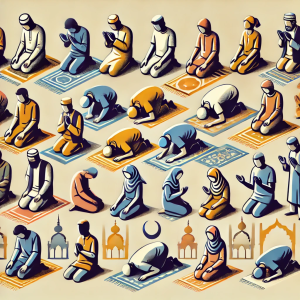By: Dr. Leah Simmons, Spiritual Wellness Expert
Prayer is a powerful spiritual practice that allows individuals to connect with the divine, seek guidance, and find inner peace. It is a universal practice found in many religious and spiritual traditions, each with its unique methods and rituals. This article explores the transformative power of prayer, various prayer techniques, and their benefits for spiritual growth and emotional well-being.

Understanding the Essence of Prayer
At its core, prayer is a form of communication with the divine or a higher power. It is an intimate and personal practice that can take many forms, including spoken words, silent thoughts, meditation, or written reflections. Prayer serves as a bridge between the physical and spiritual realms, offering individuals a way to express their deepest desires, gratitude, and concerns.
Prayer is not confined to any single religion or belief system. Whether practiced within Christianity, Islam, Hinduism, Buddhism, or other spiritual traditions, prayer remains a fundamental aspect of the human experience. It is a practice that transcends cultural and religious boundaries, uniting people in their quest for connection and meaning.

Benefits of Prayer
Prayer offers numerous benefits for the mind, body, and spirit. Some of the key benefits include:
- Spiritual Growth: Prayer deepens one’s spiritual connection and fosters a sense of closeness with the divine. It nurtures faith, strengthens beliefs, and enhances spiritual awareness.
- Emotional Well-Being: Engaging in prayer can provide comfort, solace, and emotional healing. It allows individuals to release their burdens, find hope, and cultivate a sense of peace.
- Guidance and Clarity: Prayer serves as a source of guidance and wisdom. By seeking divine direction, individuals can gain clarity on their life’s path and make decisions aligned with their higher purpose.
- Stress Reduction: Prayer promotes relaxation and reduces stress. The act of praying can calm the mind, soothe the soul, and create a sense of tranquility.
- Community and Connection: Group prayer fosters a sense of community and belonging. It strengthens social bonds, encourages mutual support, and creates a shared sense of purpose.

Different Prayer Techniques
There are various techniques and practices associated with prayer, each offering unique ways to connect with the divine. Here are some common prayer techniques:
- Vocal Prayer: Vocal prayer involves speaking words aloud, either alone or in a group. This can include reciting traditional prayers, spontaneous prayers, or chanting. Vocal prayer is a way to express thoughts and emotions verbally, creating a direct line of communication with the divine.
- Silent Prayer: Silent prayer is a form of meditation where individuals communicate with the divine through their thoughts. It involves quiet reflection, contemplation, and listening for inner guidance. Silent prayer allows for a deep, introspective connection with the divine.
- Contemplative Prayer: Contemplative prayer focuses on deepening one’s relationship with the divine through quiet contemplation and meditation. It involves resting in the presence of the divine and being open to receiving spiritual insights.
- Intercessory Prayer: Intercessory prayer involves praying on behalf of others. It is a selfless act of compassion and love, where individuals seek divine intervention and blessings for the well-being of others.
- Prayer Journaling: Prayer journaling is the practice of writing down prayers, reflections, and spiritual insights. It allows individuals to document their spiritual journey, express their thoughts, and track their progress over time.
- Guided Prayer: Guided prayer involves following a structured format or using written prayers and devotionals. It can be helpful for those new to prayer or seeking a focused approach to their practice.

Incorporating Prayer into Daily Life
To fully experience the benefits of prayer, it’s important to make it a regular part of your daily routine. Here are some tips for incorporating prayer into your daily life:
- Create a Sacred Space: Designate a quiet, peaceful area in your home for prayer and meditation. This space can include items that inspire and uplift you, such as candles, incense, spiritual symbols, and sacred texts.
- Set a Prayer Schedule: Establish a consistent time each day for prayer. Whether it’s in the morning, before bed, or during a break, having a set time helps make prayer a habit.
- Be Present: When you pray, be fully present in the moment. Focus on your breath, clear your mind of distractions, and center yourself in the act of prayer.
- Express Gratitude: Begin and end your prayers with expressions of gratitude. Thank the divine for the blessings in your life and the guidance you receive.
- Seek Guidance: Use prayer as a tool for seeking guidance and clarity. Ask for divine wisdom and insight in making decisions and navigating life’s challenges.
- Join a Prayer Group: Consider joining a prayer group or community where you can pray with others. Group prayer can enhance your spiritual experience and provide support and fellowship.
Prayer and Meditation
Prayer and meditation are complementary practices that can enhance spiritual growth and well-being. While prayer involves communicating with the divine, meditation focuses on quieting the mind and connecting with the inner self. Combining both practices can create a powerful spiritual routine that nurtures the mind, body, and spirit.

The Role of Prayer in Different Traditions
Different religious and spiritual traditions have unique approaches to prayer, reflecting their distinct beliefs and practices. Here are some examples of how prayer is practiced in various traditions:
- Christianity: Prayer in Christianity often involves reading from the Bible, reciting the Lord’s Prayer, and offering personal petitions and thanksgivings. Many Christians also engage in intercessory prayer, praying for the needs of others.
- Islam: In Islam, prayer (Salat) is performed five times a day at prescribed times. It involves a sequence of physical postures, recitations, and supplications, all directed towards Allah. The practice of Du’a, or personal supplication, is also an important aspect of Islamic prayer.
- Hinduism: Hindu prayer includes chanting mantras, performing rituals (puja), and offering prayers to various deities. Meditation and recitation of sacred texts are also integral to Hindu prayer practices.
- Buddhism: In Buddhism, prayer often takes the form of meditation, chanting, and recitation of sutras. Buddhists may also use prayer beads (mala) to count repetitions of mantras during meditation.
- Judaism: Jewish prayer includes recitation of prayers from the Siddur (prayer book), reading from the Torah, and observing religious rituals. Prayers such as the Shema and Amidah are central to Jewish worship.

The Transformative Power of Prayer
Prayer has the power to transform lives. It offers a pathway to inner peace, divine connection, and spiritual growth. By incorporating prayer into your daily routine, you can experience profound benefits for your emotional and spiritual well-being. Whether you seek guidance, comfort, or a deeper connection with the divine, prayer can be a source of strength and transformation.

Conclusion
The power of prayer lies in its ability to connect individuals with the divine, providing guidance, peace, and spiritual growth. By exploring different prayer techniques and incorporating them into your daily life, you can experience the transformative benefits of prayer. Whether practiced alone or in a community, prayer offers a sacred space for reflection, gratitude, and connection with a higher power.
Dr. Leah Simmons is a professional astrologer and sexuality counselor with a Ph.D. in Metaphysical Sciences. She specializes in helping individuals and couples understand their astrological charts to enhance sexual compatibility and deepen their relationships. Dr. Simmons provides personalized consultations and conducts workshops that integrate astrology with sexual wellness to promote harmonious and fulfilling intimate connections.


